Visiting the Venice Biennale’s main exhibition Foreigners Everywhere means encountering many different conceptions of art making – or safer would be to just say “making.” A recurrent question while navigating the exhibition is “What am I looking at?”
I speak about ownership with a member of an aboriginal clan in Australia who is present at the Arsenale. “If you ask me for my jacket, I have to give it to you, because we are related,” he says. What is earned in his community, for instance through selling paintings, is shared; there is no hierarchy between people, or animals. One of their painters, Naminapu Maymuru-White, was invited to present at the Biennale a series of bark paintings that show animal and celestial motifs, and are based on centuries-old stories. The practice requires the maker to follow patterns of depiction as they have been passed down. They are meant to invoke old wisdom, and to connect the earthly sphere with heaven, the ancestors with the present. “When I go back, I don’t have a room with nice art works, I look into the eyes of a crocodile,” the man tells me, picturing the ferocity of nature back home, far from the city. “Do you eat animals?” I ask him. “Sure, and they eat us.”
The textiles, paintings, videos, sculptures, and other artifacts presented at this year’s Biennale are made for particular reasons, though not necessarily as art. What supposedly connects all the makers in the exhibition is that they are in some way foreign, be it indigenous, refugee, queer, or otherwise outside the mainstream – that is, in the eyes of curator Adriano Pedrosa, who leads the São Paulo Museum of Art. He has chosen mostly makers who originally come from the global South, and given them full stage. Thereby he focuses on the one hand on the 20th century to show how modern art has developed in different regions in the South, producing slightly different variations on vocabularies such as abstraction in painting. On the other hand, the focus is on current practices in all their diversity.
“I don’t know what I am looking at,” a gallery owner exclaimed, after having spent a day in the exhibition. Such a response could indicate excitement about meeting the unknown, but in this case it expressed frustration. The paradox with looking at something unknown is that it only resonates in the viewer if there is some level of familiarity about the discourse in which it could be discussed, be it about form or themes, about actions or concerns. It is the curator’s task to provide that frame-work, or direct the gaze through grouping and combining works. In Venice, though, a common base is not there; there is no aesthetic argument guiding the exhibition, which makes it very hard to compare things. Every work is a window to a world, even reflecting aspects that in the secular Western societies may be missed. But this requires the viewer to shift gears in every curve while going through the show: Is it craft, folk art, criticism, spiritual practice, political activism, or documentation? All of that can be found, and more.
(…)
Read the full review on Arterritory

